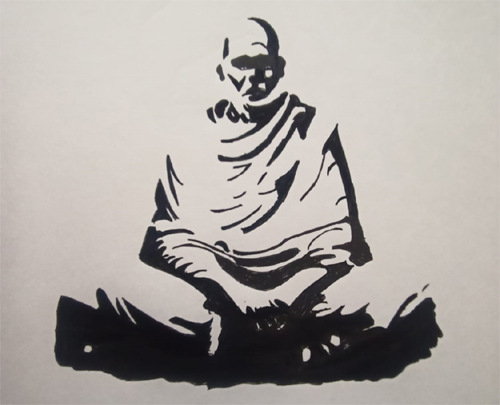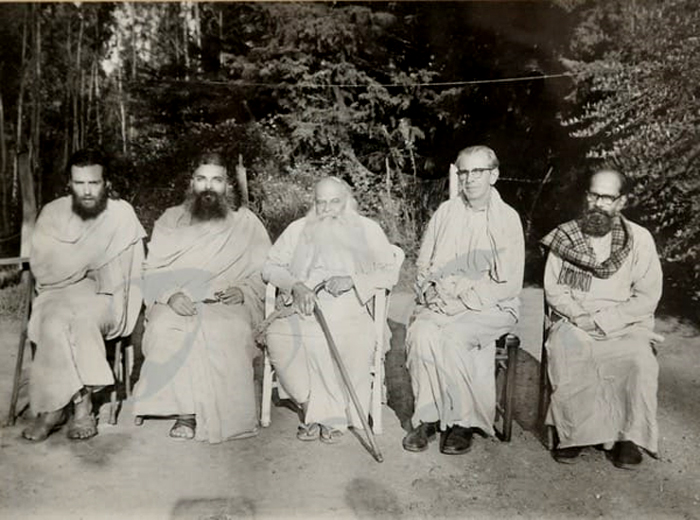
Free Hand Drawing by Devika Murali, Age 14 Years, Sivagiri Township, Bangalore.

About this 'revaluation' endeavour
This activity is a 'technological revaluation' of a rare and precious book titled DARSANA MALA by Narayana Guru, translated from the Sanskrit with Commentary by Swami Shaktidhara (Fred Hass), Narayana Gurukula, Bangalore District South published in September 1977.
This book was provided by Swamini Margaret Chaitanyamayi from the wisdom library of Narayana Gurukula, Bangalore during the 127th Birth Anniversary celebrations of Nataraja Guru in February 2022. LOKAM undertakes the task of 'revaluation' to bring this precious work in to public domain.

Swami Shaktidhara (Fred Hass)
Fred Hass, an American national, was a disciple of Swami John Spiers and lived in Bangalore. Being a seeker of Narayana Guru's wisdom of universal oneness, we can find indepth works by Fred in the 'Values' of John Spiers. Fred was known as Swami Shaktidhara and his works were profoundly influenced with the guidance in spiritual matters by Swami John Spiers. Swami Shaktidhara's translation and commentary of the DARSANA MALA - A Garland of Visions by Narayana Guru reflects his intense awareness of the Science of the Absolute.
Later, Fred Hass married a teacher from Kannur and had two sons from her. He went to USA for sometime, to earn his living working in a financial institution, but returned back after a short while to Bangalore, where he lived rest of his life with his family.

From left: Fred Hass (Swami Shaktidhara), Guru Nitya, Nataraja Guru, Swami John Spiers and Swami Mangalanada.

CONTENTS
Introduction
Chapter I
Adhyaropa Darsanam—Vision of Superimposition
Chapter II
Apavada Darsanam—Vision of Refutation
Chapter III
Asatya Darsanam—Vision of Non-Truth
Chapter IV
Maya Darsanam—Vision of Illusive Relativity
Chapter V
Bhana Darsanam—Vision of Vital Awareness
Chapter VI
Karma Darsanam—Vision of Action
Chapter VII
Jnana Darsanam—Vision of Wisdom
Chapter VIII
Bhakti Darsanam—Vision of Adoration
Chapter IX [coming soon...]
Yoga Darsanam—Vision of Unification
Chapter X [coming soon...]
Nirvana Darsanam—Vision of Nirvana

Introduction
Narayana Guru (1854-1928) composed the Darsana Mala in the year 1916. It is his most mature and major work in Sanskrit, of which nine of his compositions, are extant. The main body of his writing, over thirty compositions, are in Malayalam. The Guru also composed works in classical Tamil, but all of them are lost except for one which is called Thevarappathikangal.
The Darsana Mala is a work on Brahma Vidya or the Science of the Absolute. It is both a science and an art, both theoretical and practical. The siddhanta or final conclusion is moksha (spiritual freedom). To be free from ignorance and confusion, and to be emancipated and at peace with oneself and one's fellows is the goal of all Hindu spirituality. For this reason all important sastras are called moksha sastras. The attainment of spiritual freedom is never accomplished by mere metaphysical and abstract philosophical speculation. It is accomplished by applying theoretical wisdom to the practical wisdom and spiritual discipline (sadhana) which is generally given to the aspirant by his Guru.
The word darsana means vision or view. It is like the German word Weltanschauung which means a vision of life or a world view. Mala is a garland. We can picture to ourselves a garland comprised of ten lovely flowers. We can choose any colours we wish. Each flower has a loveliness all its own, yet it is an intrinsic part of the garland as a whole. The flowers are attached to an almost invisible thread which symbolizes the sutra atma or Thread Self. Without the Self there would be no darsana flowers at all.
Hindu philosophy is of the darsana type. Our ancient sages taught us that Truth is one though expressed in different ways. This mature attitude produces a tolerance of viewpoints, which is also reflected in the general attitudes of the people. Hinduism has many viewpoints or darsanas, yet all of them have the common ideal of moksha. Even the Materialistic (yet ethically idealistic) Charvaka darsana gives moksha the highest place.
Narayana Guru has no particular doctrine or creed which he wants us to blindly believe. The Darsana Mala is beyond all creeds. Being a darsana, it could not be otherwise. The Guru deals with ten different subjects, all important in themselves, and part of the Hindu spiritual tradition. The first is Adhyaropa or superimposition. Sankaracharya prefaces his commentary on the Brahma Sutras with a most illuminating description of superimposition and teaches us how to overcome it.
The last chapter of the Darsana Mala is called Nirvana Darsana. We left Nirvana untranslated because there is no English equivalent. It is nowadays assumed by many westerners that Nirvana is attained when taking L.S.D. This was first popularised by Aldous Huxley because he thought consciousness is dualistic and something which 'expands'. Later during the Hippy Revolution people like Dr. Timothy Leary described the effects of L.S.D. on the drug-soaked mind as Nirvana.
The spirit of western man is choked and wants mystical experience, but Nirvana has never been described this way in the Hindu sastras, although it is admitted that various types of secondary visions can be experienced through the use of herbal drugs. As we will see, Narayana Guru uses the term Nirvana in its traditional sense, although he does say that a person who desires siddhis is an impure-impure (asuddha-asuddha) type seeking Nirvana. L.S.D. and similar drugs belong to the siddhi complex.
Narayana Guru says in his own gloss on the Darsana Mala that Nirvana is the most important of all the chapters. It is the most important because it is the siddhanta. After the reader has gone through the first nine chapters he is now in a position to realize the siddhanta. Whatever particular ideas or concepts he may have picked up on the way, he must gently put aside. As the Guru declares:
By himself not knowing, even a little, then
in like manner does not know (by another),
He is the most excellent, always void of
these movements (of the mind) being the
Absolute alone. (X. 8)
It is at this point that we fully taste and experience the Absolute. We are now beyond name and form. The limitations of concepts and percepts vanish in the light of the pure non-dual Self-Absolute.
Finally we offer our pranams to our Guru, Swami John Spiers. Whatever value this translation and commentary has is due to his guidance in spiritual matters. He has been our Guru for over fifteen years, and his influence has been profound.
Let us now proceed to the Darsana Mala.
